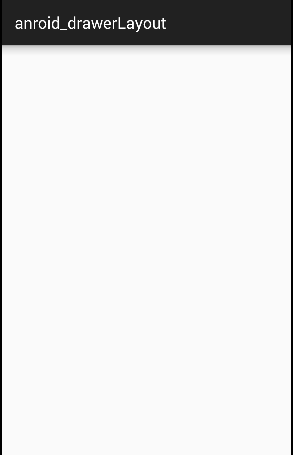(1)概述
本節給大家帶來基礎UI控件部份的最后1個控件:DrawerLayout,官方給我們提供的1個側滑菜單控件,和上1節的ViewPager1樣,3.0以后引入,低版本使用它,需要v4兼容包,既然Google為我們提供了這個控件,為什么不用咧,而且在 Material Design設計規范中,隨處可見的很多側滑菜單的動畫效果,大都可以通過Toolbar + DrawerLayout來實現~,本節我們就來探究下這個DrawerLayout的1個基本用法~還有人喜歡把他
稱為抽屜控件~
(2)使用的注意事項
1.主內容視圖1定要是DrawerLayout的第1個子視圖
2.主內容視圖寬度和高度需要match_parent
3.必須顯示指定側滑視圖的android:layout_gravity屬性
android:layout_gravity = “start”時,從左向右滑出菜單
android:layout_gravity = “end”時,從右向左滑出菜單
不推薦使用left和right !!!
側滑視圖的寬度以dp為單位,不建議超過320dp(為了總能看到1些主內容視圖)
設置側滑事 件:
mDrawerLayout.setDrawerListener(DrawerLayout.DrawerListener);
要說1點:可以結合Actionbar使用當用戶點擊Actionbar上的利用圖標,彈出側滑菜單! 這里就要通過ActionBarDrawerToggle,它是DrawerLayout.DrawerListener的具體實現類, 我們可以重寫ActionBarDrawerToggle的onDrawerOpened()onDrawerClosed()以監聽抽屜拉出 或隱藏事件!但是這里我們不講,由于5.0后我們使用的是Toolbar!有興趣的可以自行查閱相干 文檔!
使用代碼案例
案例1:單個側滑菜單的實現
運行效果圖:

實現關鍵代碼:
首先是我們的主布局,注意:最外層要是DrawerLayout哦!!!!
activity_main.xml:
<android.support.v4.widget.DrawerLayout xmlns:android="http://schemas.android.com/apk/res/android"
android:id="@+id/drawer_layout"
android:layout_width="match_parent"
android:layout_height="match_parent">
<FrameLayout
android:id="@+id/ly_content"
android:layout_width="match_parent"
android:layout_height="match_parent" />
<ListView
android:id="@+id/list_left_drawer"
android:layout_width="180dp"
android:layout_height="match_parent"
android:layout_gravity="start"
android:background="#080808"
android:choiceMode="singleChoice"
android:divider="#FFFFFF"
android:dividerHeight="1dp" />
</android.support.v4.widget.DrawerLayout>接著ListView的布局代碼和domain類:Item比較簡單,就不給出了,直接上中間Fragment的
布局和代碼吧!另外Adapter直接復用我們之前寫的那個可復用的MyAdapter!
fg_content.xml:
<?xml version="1.0" encoding="utf⑻"?>
<RelativeLayout xmlns:android="http://schemas.android.com/apk/res/android"
android:layout_width="match_parent"
android:layout_height="match_parent"
android:orientation="vertical">
<TextView
android:id="@+id/tv_content"
android:layout_width="wrap_content"
android:layout_height="wrap_content"
android:layout_centerInParent="true"
android:textSize="25sp" />
</RelativeLayout>ContentFragment.java
public class ContentFragment extends Fragment {
private TextView tv_content;
@Override
public View onCreateView(LayoutInflater inflater, ViewGroup container, Bundle savedInstanceState) {
View view = inflater.inflate(R.layout.fg_content, container, false);
tv_content = (TextView) view.findViewById(R.id.tv_content);
String text = getArguments().getString("text");
tv_content.setText(text);
return view;
}
}最后是我們的Activity類
MainActivity.java:
public class MainActivity extends AppCompatActivity implements AdapterView.OnItemClickListener{
private DrawerLayout drawer_layout;
private ListView list_left_drawer;
private ArrayList<Item> menuLists;
private MyAdapter<Item> myAdapter = null;
@Override
protected void onCreate(Bundle savedInstanceState) {
super.onCreate(savedInstanceState);
setContentView(R.layout.activity_main);
drawer_layout = (DrawerLayout) findViewById(R.id.drawer_layout);
list_left_drawer = (ListView) findViewById(R.id.list_left_drawer);
menuLists = new ArrayList<Item>();
menuLists.add(new Item(R.mipmap.iv_menu_realtime,"實時信息"));
menuLists.add(new Item(R.mipmap.iv_menu_alert,"提示通知"));
menuLists.add(new Item(R.mipmap.iv_menu_trace,"活動線路"));
menuLists.add(new Item(R.mipmap.iv_menu_settings,"相干設置"));
myAdapter = new MyAdapter<Item>(menuLists,R.layout.item_list) {
@Override
public void bindView(ViewHolder holder, Item obj) {
holder.setImageResource(R.id.img_icon,obj.getIconId());
holder.setText(R.id.txt_content, obj.getIconName());
}
};
list_left_drawer.setAdapter(myAdapter);
list_left_drawer.setOnItemClickListener(this);
}
@Override
public void onItemClick(AdapterView<?> parent, View view, int position, long id) {
ContentFragment contentFragment = new ContentFragment();
Bundle args = new Bundle();
args.putString("text", menuLists.get(position).getIconName());
contentFragment.setArguments(args);
FragmentManager fm = getSupportFragmentManager();
fm.beginTransaction().replace(R.id.ly_content,contentFragment).commit();
drawer_layout.closeDrawer(list_left_drawer);
}
}
代碼很簡單,就不多說了~
(3)左右兩個側滑菜單的實現
不知道你有無發現,從上面的DrawerLayout的布局,我們大概可以猜到,DrawerLayout
最多由3個部份組成,中間的內容部份,左側的側滑菜單部份,右側的側滑菜單部份組成!
下面我們來寫1個帶有兩個側滑菜單的示例!
運行效果:

代碼實現:
————首先我們創建兩個Fragment和對應的布局,他們分別是左右邊滑菜單!
左側Fragment:
布局:fg_left.xml,這里就用了1個圖片而以,點擊后彈出1個新的Activity;
固然你可以根據自己的需求進行擴大!
<?xml version="1.0" encoding="utf⑻"?>
<LinearLayout xmlns:android="http://schemas.android.com/apk/res/android"
android:orientation="vertical" android:layout_width="match_parent"
android:layout_height="match_parent">
<ImageView
android:id="@+id/img_bg"
android:layout_width="match_parent"
android:layout_height="match_parent"
android:background="@mipmap/bg_menu_left"/>
</LinearLayout>對應的LeftFragment.java:
public class LeftFragment extends Fragment{
private DrawerLayout drawer_layout;
@Override
public View onCreateView(LayoutInflater inflater, ViewGroup container, Bundle savedInstanceState) {
View view = inflater.inflate(R.layout.fg_left, container, false);
ImageView img_bg = (ImageView) view.findViewById(R.id.img_bg);
img_bg.setOnClickListener(new View.OnClickListener() {
@Override
public void onClick(View v) {
getActivity().startActivity(new Intent(getActivity(),OtherActivity.class));
drawer_layout.closeDrawer(Gravity.START);
}
});
return view;
}
//暴露給Activity,用于傳入DrawerLayout,由于點擊后想關掉DrawerLayout
public void setDrawerLayout(DrawerLayout drawer_layout){
this.drawer_layout = drawer_layout;
}
}右面的Fragment:
布局就3個按鈕,點擊后替換中間部份的Fragment,布局fg_right.xml代碼以下:
<?xml version="1.0" encoding="utf⑻"?>
<LinearLayout xmlns:android="http://schemas.android.com/apk/res/android"
android:layout_width="match_parent"
android:layout_height="match_parent"
android:background="#2F9AF2"
android:gravity="center"
android:orientation="vertical">
<Button
android:id="@+id/btn_one"
android:layout_width="wrap_content"
android:layout_height="wrap_content"
android:text="菜單項1" />
<Button
android:id="@+id/btn_two"
android:layout_width="wrap_content"
android:layout_height="wrap_content"
android:text="菜單項2" />
<Button
android:id="@+id/btn_three"
android:layout_width="wrap_content"
android:layout_height="wrap_content"
android:text="菜單項3" />
</LinearLayout>然后對應的是RightFragment.java:
public class RightFragment extends Fragment implements View.OnClickListener{
private DrawerLayout drawer_layout;
private FragmentManager fManager;
@Override
public View onCreateView(LayoutInflater inflater, ViewGroup container, Bundle savedInstanceState) {
View view = inflater.inflate(R.layout.fg_right, container, false);
view.findViewById(R.id.btn_one).setOnClickListener(this);
view.findViewById(R.id.btn_two).setOnClickListener(this);
view.findViewById(R.id.btn_three).setOnClickListener(this);
fManager = getActivity().getSupportFragmentManager();
return view;
}
@Override
public void onClick(View v) {
switch (v.getId()){
case R.id.btn_one:
ContentFragment cFragment1 = new ContentFragment("1.點擊了右邊菜單項1",R.color.blue);
fManager.beginTransaction().replace(R.id.fly_content,cFragment1).commit();
drawer_layout.closeDrawer(Gravity.END);
break;
case R.id.btn_two:
ContentFragment cFragment2 = new ContentFragment("2.點擊了右邊菜單項2",R.color.red);
fManager.beginTransaction().replace(R.id.fly_content,cFragment2).commit();
drawer_layout.closeDrawer(Gravity.END);
break;
case R.id.btn_three:
ContentFragment cFragment3 = new ContentFragment("3.點擊了右邊菜單項3",R.color.yellow);
fManager.beginTransaction().replace(R.id.fly_content,cFragment3).commit();
drawer_layout.closeDrawer(Gravity.END);
break;
}
}
public void setDrawerLayout(DrawerLayout drawer_layout){
this.drawer_layout = drawer_layout;
}
}
另外還有1個中間部份填充的ContentFragment,布局:fg_content.xml以下:
<?xml version="1.0" encoding="utf⑻"?>
<RelativeLayout xmlns:android="http://schemas.android.com/apk/res/android"
android:layout_width="match_parent"
android:layout_height="match_parent"
android:orientation="vertical">
<TextView
android:id="@+id/tv_content"
android:layout_width="wrap_content"
android:layout_height="wrap_content"
android:layout_centerInParent="true"
android:textSize="25sp" />
</RelativeLayout>對應的ContentFragment.java:
public class ContentFragment extends Fragment {
private TextView tv_content;
private String strContent;
private int bgColor;
public ContentFragment(String strContent,int bgColor) {
this.strContent = strContent;
this.bgColor = bgColor;
}
@Override
public View onCreateView(LayoutInflater inflater, ViewGroup container, Bundle savedInstanceState) {
View view = inflater.inflate(R.layout.fg_content, container, false);
view.setBackgroundColor(getResources().getColor(bgColor));
tv_content = (TextView) view.findViewById(R.id.tv_content);
tv_content.setText(strContent);
return view;
}
}
編寫好以后,就到我們的Activity的布局了和Activity的代碼了:
在此之前我們還需要些1個頂部條形欄的布局:
view_topbar.xml:
<?xml version="1.0" encoding="utf⑻"?>
<RelativeLayout xmlns:android="http://schemas.android.com/apk/res/android"
android:layout_width="match_parent"
android:layout_height="wrap_content"
android:background="#DCDEDB">
<Button
android:id="@+id/btn_right"
android:layout_width="40dp"
android:layout_height="40dp"
android:layout_centerVertical="true"
android:layout_alignParentRight="true"
android:background="@drawable/btn_selctor"/>
</RelativeLayout>然后是activity_main.xml:
<android.support.v4.widget.DrawerLayout xmlns:android="http://schemas.android.com/apk/res/android"
xmlns:tools="http://schemas.android.com/tools"
android:id="@+id/drawer_layout"
android:layout_width="match_parent"
android:layout_height="match_parent">
<LinearLayout
android:layout_width="match_parent"
android:layout_height="match_parent"
android:orientation="vertical">
<include
android:id="@+id/topbar"
layout="@layout/view_topbar"
android:layout_width="wrap_content"
android:layout_height="48dp" />
<FrameLayout
android:id="@+id/fly_content"
android:layout_width="match_parent"
android:layout_height="match_parent" />
</LinearLayout>
<fragment
android:id="@+id/fg_left_menu"
android:name="eliot.wakfo.com.anroid_drawerlayout.LeftFragment"
android:layout_width="300dp"
android:layout_height="match_parent"
android:layout_gravity="start"
android:tag="LEFT"
tools:layout="@layout/fg_left" />
<fragment
android:id="@+id/fg_right_menu"
android:name="eliot.wakfo.com.anroid_drawerlayout.LeftFragment"
android:layout_width="100dp"
android:layout_height="match_parent"
android:layout_gravity="end"
android:tag="RIGHT"
tools:layout="@layout/fg_right" />
</android.support.v4.widget.DrawerLayout> 最后是MainActivity.java:
public class MainActivity extends AppCompatActivity implements View.OnClickListener {
private DrawerLayout drawer_layout;
private FrameLayout fly_content;
private View topbar;
private Button btn_right;
private RightFragment fg_right_menu;
private LeftFragment fg_left_menu;
private FragmentManager fManager;
@Override
protected void onCreate(Bundle savedInstanceState) {
super.onCreate(savedInstanceState);
setContentView(R.layout.activity_main);
fManager = getSupportFragmentManager();
fg_right_menu = (RightFragment) fManager.findFragmentById(R.id.fg_right_menu);
fg_left_menu = (LeftFragment) fManager.findFragmentById(R.id.fg_left_menu);
initViews();
}
private void initViews() {
drawer_layout = (DrawerLayout) findViewById(R.id.drawer_layout);
fly_content = (FrameLayout) findViewById(R.id.fly_content);
topbar = findViewById(R.id.topbar);
btn_right = (Button) topbar.findViewById(R.id.btn_right);
btn_right.setOnClickListener(this);
//設置右面的側滑菜單只能通過編程來打開
drawer_layout.setDrawerLockMode(DrawerLayout.LOCK_MODE_LOCKED_CLOSED,
Gravity.END);
drawer_layout.setDrawerListener(new DrawerLayout.DrawerListener() {
@Override
public void onDrawerSlide(View view, float v) {
}
@Override
public void onDrawerOpened(View view) {
}
@Override
public void onDrawerClosed(View view) {
drawer_layout.setDrawerLockMode(
DrawerLayout.LOCK_MODE_LOCKED_CLOSED, Gravity.END);
}
@Override
public void onDrawerStateChanged(int i) {
}
});
fg_right_menu.setDrawerLayout(drawer_layout);
fg_left_menu.setDrawerLayout(drawer_layout);
}
@Override
public void onClick(View v) {
drawer_layout.openDrawer(Gravity.END);
drawer_layout.setDrawerLockMode(DrawerLayout.LOCK_MODE_UNLOCKED,
Gravity.END); //消除鎖定
}
}
好的,至此就大功告成了~,呼呼,下面說下看代碼時可能會有的疑惑:
1. drawer_layout.openDrawer(Gravity.END);
這句是設置打開的哪一個菜單START代表左側,END代表右側
2.
drawer_layout.setDrawerLockMode(DrawerLayout.LOCK_MODE_LOCKED_CLOSED,Gravity.END);
鎖定右面的側滑菜單,不能通過手勢關閉或打開,只能通過代碼打開!即調用openDrawer方
法!
接著
drawer_layout.setDrawerLockMode(DrawerLayout.LOCK_MODE_UNLOCKED,Gravity.END);
消除鎖定狀態,便可以通過手勢關閉側滑菜單
最后在drawer關閉的時候調用:
drawer_layout.setDrawerLockMode(DrawerLayout.LOCK_MODE_LOCKED_CLOSED,
Gravity.END);
再次鎖定右側的側滑菜單!
3. 布局代碼中的Tag屬性的作用?
答:這里沒用到,在重寫DrawerListener的onDrawerSlide方法時,我們可以通過他的第1個
參數drawerView,調用drawerView.getTag().equals(“START”)判斷觸發菜單事件的是哪一個
菜單!然后可以進行對應的操作!
<完>
